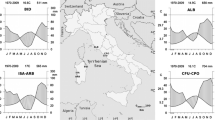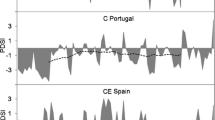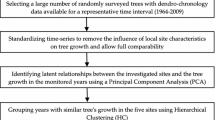Abstract
Sensitivity to climate change and anthropogenic disturbance is a typical feature of Mediterranean forests, which grow under dynamic and manipulated environmental conditions. In this study, we examine stone pine (Pinus pinea L.) along the Tyrrhenian coast of Italy to analyse the tree-growth variability on a temporal scale and to evaluate the radial growth response to climate trends over the last century. The analysis of tree ring widths at the decadal and multidecadal scale, which were standardised to remove the age trend, showed primarily significant downward trends and time periods with lower growth rates. Characterised by a clear decline in tree ring widths, the two periods of 20 years from the mid-1920s and the early 1970s appeared to be the least favourables for tree growth. Precipitation was the main factor driving growth, and the effect was cumulative over consecutive years because of the increase in soil water content. Including the current year of ring formation, correlations between decline in precipitation and tree growth were greatest with 3-year precipitation sums. The shifting influence of winter rainfall on tree ring growth toward not significant values during the last decades, together with the lack of significant correlation between the current year’s precipitation and growth decline from the 1970s, might suggest an increasingly dependence on long periods of water supply to utilise the water content stored due to the previous rainy years. The negative effect on tree-growth decline of summer and early-fall temperatures appeared as a forcing influence related to long-term changes in climate rather than high-frequency climate fluctuations.




Similar content being viewed by others
References
Benjamini Y, Hochberg Y (1995) Controlling the false discovery rate—a practical and powerful approach to multiple testing. J R Stat Soc Ser B 57:289–300
Briffa KR, Jones PD (1990) Basic chronology statistics and assessment. In: Cook ER, Kairiukstis LA (eds) Methods of dendrochronology: applications in the environmental sciences. Kluwer Academic Publishers, Dordrecht, pp 137–152
Briffa KR, Osborn TJ, Schweingruber FH, Harris IC, Jones PD, Shiyatov SG, Vaganov EA (2001) Low-frequency temperature variations from a northern tree ring density network. J Geophys Res 106(D3):2929–2941
Brunetti M, Maugeri M, Monti F, Nanni T (2006) Temperature and precipitation in Italy in the last two centuries from homogenised instrumental time series. Int J Climatol 26:345–381
Bunn AG (2008) A dendrochronology program library in R (dplR). Dendrochronologia 26:115–124
Bunn AG (2010) Statistical and visual crossdating in R using the dplR library. Dendrochronologia 28:251–258
Bussotti F (1997) Stone pine (Pinus pinea L.). Sherwood Foreste ed Alberi Oggi 3(11):31–34
Campelo F, Nabais C, Freitas H, Gutiérrez E (2006) Climatic significance of tree-ring width and intra-annual density fluctuations in Pinus pinea from dry Mediterranean area in Portugal. Ann For Sci 64:229–238
Carrer M, Nola P, Motta R, Urbinati C (2010) Contrasting tree-ring growth to climate responses of Abies alba toward the southern limit of its distribution area. Oikos 000:001–011
Cherubini P, Gartner BL, Tognetti R, Bräker OU, Schoch W, Innes JL (2003) Identification, measurement and interpretation of tree rings in woody species from Mediterranean climates. Biol Rev 78:119–148
Cook ER, Peters K (1981) The smoothing spline: a new approach to standardizing forest interior tree-ring width series for dendroclimatic studies. Tree-Ring Bull 41:45–53
Cook E, Briffa K, Shiyatov S, Mazepa V (1990) Tree-ring standardization and growth-trend estimation. In: Cook ER, Kairiukstis LA (eds) Methods of dendrochronology. Kluwer Academic Publishers, Dordrecht, pp 104–123
De Luis M, Novak K, Čufar K, Raventós J (2009) Size mediated climate–growth relationships in Pinus halepensis and Pinus pinea. Trees 23:1065–1073
Dünkeloh A, Jacobeit J (2003) Circulation dynamics of Mediterranean precipitation variability 1948–98. Int J Climatol 23:1843–1866
Frattegiani M, Mencuccini M, Mercurio R, Profili W (1994) Quantitative analysis of Stone pine (Pinus pinea L.) root systems morphology and its relationships with water table and soil characters. Investigasión Agraria Fuera de Ser 3:405–416
Fritts HC (1976) Tree rings and climate. Academic, New York
Gandolfo GP (1999) Fattori ambientali, relazioni idriche e dendroecologia del pino domestico (Pinus pinea L.) ad Alberese (GR). Tesi di Dottorato in Ecologia Forestale, XII ciclo, Università degli Studi di Padova
Gibelin AL, Dèquè M (2003) Anthropogenic climate change over the Mediterranean region simulated by a global variable resolution model. Clim Dyn 20:327–339
Hamed KH (2008) Trend detection in hydrologic data: the Mann–Kendall trend test under the scaling hypothesis. J Hydrol 349:350–363
IPCC, WG I (2007) Climate change 2007: the physical science basis. Contribution of Working Group I. In: Solomon S et al (eds) Fourth assessment report of the intergovernmental panel on climate change. Cambridge University Press, Cambridge
Kozlowski TT, Kramer PJ, Pallardy SG (1991) The physiological ecology of woody plants. Academic, New York
Kramer K, Leinonen I, Loustau D (2000) The importance of phenology for the evaluation of impact of climate change on growth of boreal, temperate and Mediterranean forests ecosystems: an overview. Int J Biometeorol 44:67–75
Mazza G, Amorini E, Cutini A, Manetti MC (2011) The influence of thinning on rainfall interception by Pinus pinea L. in Mediterranean coastal stands (Castel Fusano–Rome). Ann For Sci 68:1323–1332
Osborne CP, Mitchell PL, Sheehy JE, Woodward FI (2000) Modelling the recent impacts of atmospheric CO2 and climate change on Mediterranean vegetation. Glob Chang Biol 6:445–458
Perez-Antelo A, Fernandez-Cancio A (1992) A dendrochronology of Pinus pinea in Central Spain. In: “Tree rings and environment”. Proceedings of the International dendrological symposium, Ystad, South Sweden, 3–9 September 1990. Lundqua Report pp. 254–255
Raddi S, Cherubini P, Lauteri M, Magnani F (2009) The impact of sea erosion on coastal Pinus pinea stands: a diachronic analysis combining tree-rings and ecological markers. For Ecol Manag 257(3):773–781
Resco de Dios V, Fischer C, Colinas C (2007) Climate change effects on mediterranean forests and preventive measures. New Forest 33:29–40
Sarris D, Christoduolakis D, Körner C (2007) Recent decline in precipitation and tree growth in the eastern Mediterranean. Glob Chang Biol 13(6):1187–1200
Sarris D, Christoduolakis D, Körner C (2011) Impact of recent climatic change on growth of low elevation eastern Mediterranean forest trees. Clim Chang 106(2):203–223
Schweingruber FH (1989) Tree rings: basics and applications of dendrochronology. Kluwer Academic Publishers, Dordrecht
Teobaldelli M, Mencuccini M, Piussi P (2004) Water table salinity, rainfall and water use by umbrella pine trees (Pinus pinea L.). Plant Ecol 171:23–33
Wigley TML, Briffa KR, Jones PD (1984) On the average value of correlated time series with application in dendroclimatology and hydrometeorology. J Clim Appl Meteorol 23:201–221
Acknowledgments
This research was funded by the Municipality of Rome project “Management of stone pine (Pinus pinea L.) pinewood within the National Natural Reserve of the Roman Coast” and partially financed by the Italian Ministry of Agricultural and Forestry Policies project Ri.SELV.ITALIA–3.1.1 “Management and conservation of stone pine coastal stands”. We are grateful to the personnel from Castelporziano Presidential Estate, Azienda Regionale di Alberese and Maremma Regional Park for sites access and collaboration. We wish to thank the colleagues from the Forestry Research Centre (CRA-SEL) that helped in the field work and the three anonymous referees for their suggestions that helped to improve the original version of the paper.
Author information
Authors and Affiliations
Corresponding author
Rights and permissions
About this article
Cite this article
Mazza, G., Manetti, M.C. Growth rate and climate responses of Pinus pinea L. in Italian coastal stands over the last century. Climatic Change 121, 713–725 (2013). https://doi.org/10.1007/s10584-013-0933-y
Received:
Accepted:
Published:
Issue Date:
DOI: https://doi.org/10.1007/s10584-013-0933-y




